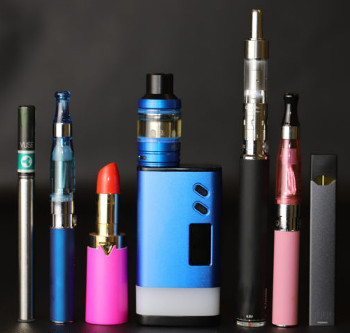 As if keeping up with a pack and lighter wasn't enough, imagine not feeling comfortable leaving home until your e-cig battery is charged and its tank full of juice.
As if keeping up with a pack and lighter wasn't enough, imagine not feeling comfortable leaving home until your e-cig battery is charged and its tank full of juice.
As if non-smoker stares and disdain weren't enough, reflect on how silly it looks to them that the cigarette has grown, with some nearly as big as a baby bottle, and often sucked as intensely.
E-cig user testimonials often start something like these:
- "I tried going cold turkey and lasted about two days before a stressful situation proved my downfall."
- "I smoked real cigarettes for over 15 years and had never been able to quit."
- "I'd tried everything … gum, patches, Chantix, you name it. I was even hypnotized once."
The common thread? Each was a failure at quitting. But why?
I may want to bake cookies but without a recipe, trial and error could prove frustrating and messy.
And successful nicotine dependency recovery is really that simple. Notice, I didn't say "easy." It's as simple as reading, accepting, and applying the Law of Addiction (Chapter 2).
Most current e-cig users were smokers. Most were totally convinced that a key reason they continued smoking was for the aromatic smells and ultra-fine flavors experienced when inhaling fine tobacco.
"Come to where the flavor is!" This use belief fit snugly into years of Marlboro logo brainwashing.
What's mind-boggling is how quickly new e-cig users abandon this core use conviction. What's amazing is that even while selecting their e-cig juice nicotine level (0, 6, 12, 18, and 24 milligrams per 1 milliliter of e-liquid), most do so without being slapped hard by the epiphany that, no different from the alcoholic or meth addict, "I'm slave to a drug."
Many smokers switch to e-cigs thinking that once they've transferred that they'll then gradually wean themselves off. As smokers, they were always free to smoke one less cigarette a day. How did that work out?
Is transfer from the deadliest nicotine delivery device to one where science doesn't yet know the long-term health consequences worthy of celebration? If buying the message being pushed by e-cig peddlers it certainly is.
Are e-cigarettes safer than cigarettes? Absolutely. Let's say that again. Absolutely. Are e-cigs unsafe? Absolutely!
Forget for a moment that animal studies have linked nicotine to cancer promotion,[1] circulatory disease,[2] diabetes,[3] DNA damage,[4] fertility concerns,[5] and fetal harm.[6]
What if you were to become a slave to vaped nicotine yet unable to stop smoking?
A 2015 study found that 72 percent of the most dedicated e-cig users of all - the every-day vape bellowing e-cig tank users - are still smoking cigarettes too, as are 89% of daily pen-like e-cig users.[7]
Forget for a moment concerns about a lithium-ion battery exploding in your mouth or pocket, or nicotine poisoning of a child or pet who stumbled upon and toyed with your e-juice bottle. Like nicotine, vaporized e-juice sugars stimulate brain dopamine pathways.
Sugars are intended to be chewed, swallowed and digested, not inhaled into our lungs and transported to the brain within seconds.
 Physiologically, once ready to reclaim your brain, how challenging will it be to say "no more" to dopamine "aaah" wanting relief sensations tied in whole or part to e-cig sugars?
Physiologically, once ready to reclaim your brain, how challenging will it be to say "no more" to dopamine "aaah" wanting relief sensations tied in whole or part to e-cig sugars?
Psychologically, forget for a moment all the new conditioned use urge triggers created by being able to vape in places where you couldn't or didn't smoke. How difficult would it be to eventually stop using e-cigs if deeply convinced that vaping is safer than smoking?
Today, 62.4% of surveyed e-cigarette users want to quit.[8] Is it easier or harder to stop vaping? How much of the motivation to quit smoking is rooted in life-threatening concerns about smoking-induced cancers, emphysema, strokes, or heart attacks: 10%, 25%, 50%?
Neo-nicotine industry marketing uses smoking's risks to prey upon the never-ending cycle of wanting within a chemically enslaved mind. It sells risky as safe, bondage as freedom, and electronically fed drug addiction as new, exciting, and fun.
What it cannot tell you is this. What are the long-term health risks associated with inhaling vaporized nicotine and a wide array of e-cig additives and flavorings into lungs already damaged by years of smoking?
What it won't tell you is that nearly all comfortably recovered nicotine addicts arrested their chemical dependency by going cold, via abrupt nicotine cessation.
What it will never volunteer is that nicotine withdrawal peaks within 3 days of ending use, or that being free, home, calm and comfortable is infinitely more wonderful than feeding a never-ending chemical need, an urge that will demand satisfaction every waking hour of every day until silenced by death.
References:
2. Heeschen C1, Weis M, Cooke JP, Nicotine promotes arteriogenesis, Journal of the American College of Cardiology, February 2003, Volume 5;41(3), Pages 489-496.
3. Jain G1, Jaimes EA, Nicotine signaling and progression of chronic kidney disease in smokers. Biochemical Pharmacology, Oct. 2013, Volume 86(8), Pages 121512-23.
4. Kushwaha S, Jena GB, Effects of nicotine on the testicular toxicity of streptozotocin-induced diabetic rat: intervention of enalapril. Human & Experimental Toxicology, June 2014, Volume 33(6), Pages 609-622.
5. Holloway AC et al, Fetal and neonatal exposure to nicotine disrupts ovarian function and fertility in adult female rats. Endocrine, Oct. 2006, Volume 30(2), Pages 213-216.
6. Slotkin TA, Seidler FJ, Spindel ER. Prenatal nicotine exposure in rhesus monkeys compromises development of brainstem and cardiac monoamine pathways involved in perinatal adaptation and sudden infant death syndrome: amelioration by vitamin C. Neurotoxicology & Teratology, May-Jun 2011, Volume 33(3), Pages 431-434.
7. Hitchman, SC et. al, Associations Between E-Cigarette Type, Frequency of Use, and Quitting Smoking: Findings From a Longitudinal Online Panel Survey in Great Britain, Nicotine & Tobacco Research, Oct. 2015, Volume 17(10), Pages 1187-1194. (see bottom of Table 3).
8. Rosen RL, Steinberg ML. Interest in Quitting E-cigarettes Among Adults in the United States. Nicotine Tob Res. 2020;22(5):857-858. doi:10.1093/ntr/ntz062
All rights reserved
Published in the USA
